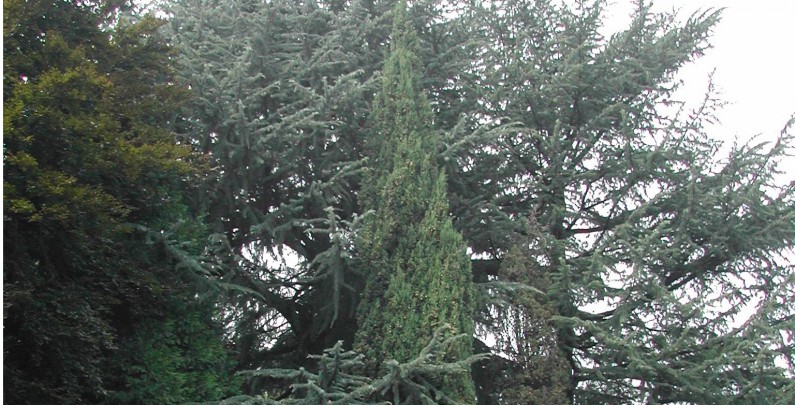
Originating from the eastern Mediterranean countries and introduced into Italy at the time of the Phoenicians, the cypress today is a very diffused plant in the delightful gardens of Lombardy, within the natural weft throughout the country. The cypress, in fact, is considered a typical plant of the Italian Mediterranean regions.
More
The entrance path to the noble courtyard that connected Villa Crivelli Pusterla to the city of Limbiate, was endowed with a line of cypress trees (Cupressus sempervirens) no longer existing today. As a reminder of this, only some examples of these conifers remain, in front of the internal pavilions of the provincial asylum.
The cypress trees inside what remains of the romantic garden of the villa, mostly transformed between the end of the 19th and start of the 20th centuries, have a pyramid shape like a flame, and their branches are erect and close to the trunk. The crown, in fact, is tightly pointed and stretched upwards. This is a monoecious species; the yellowish male catkins form at the tip of the branches while the female conelets are brownish. The dark green, scale-like leaves are arranged on four rows. The fruits are called cones and are light green that is almost silver. When immature they have tightly closed scales which become woody upon reaching maturity and the scales open to let the seeds fall to the ground. The bark is brownish green, with long fissures. The wood is very hard, and was used by the Mediterranean population for all sorts of construction, given that the aromatic fragrance of the wood is a natural termicide.
According to the ancient authors, cypress plants purify the air and oriental doctors recommended that some patients visit the Isle of Crete, where these trees abound. The leaves and fruits contain a very aromatic essential oil which the Romans used to prepare perfumes. Tinctures of the cypress in teas or herbal infusions, still today are used as treatments to protect the capillaries while the essence of the branches is used as a sedative for coughs.
The cypress has always been considered a funerary tree as various Greek and Italian poets recall. Ovid narrates in his Metamorphosis that the youthful Cyparissus accidentally killed his pet, a golden-horned deer. Filled with despair he decided to kill himself and asked the gods only for one privilege after death: to be able to mourn eternally. He was thus transformed into a tree that bears his name. This funerary symbolism is not confirmed in the East where, due to its vaguely phallic shape, it is considered the tree of fertility. It was also the plant image for immortality due to the persistent leaves, typical of the evergreens, and the wood, considered as incorruptible and from which material was taken to make the arrow of Eros, the scepter of Zeus and Hercules’s hammer.
In the past centuries, there was the diffusion of rows of cypress trees which lined the paths leading towards the noble country villas and ancient homes of the Lombard nobles. These trees were imported from Tuscany, the areas around Garda Lake and the Verona zones, where cypress trees are historically known to have elegantly adorned the knolls and entrance lanes.
The cypress trees inside what remains of the romantic garden of the villa, mostly transformed between the end of the 19th and start of the 20th centuries, have a pyramid shape like a flame, and their branches are erect and close to the trunk. The crown, in fact, is tightly pointed and stretched upwards. This is a monoecious species; the yellowish male catkins form at the tip of the branches while the female conelets are brownish. The dark green, scale-like leaves are arranged on four rows. The fruits are called cones and are light green that is almost silver. When immature they have tightly closed scales which become woody upon reaching maturity and the scales open to let the seeds fall to the ground. The bark is brownish green, with long fissures. The wood is very hard, and was used by the Mediterranean population for all sorts of construction, given that the aromatic fragrance of the wood is a natural termicide.
According to the ancient authors, cypress plants purify the air and oriental doctors recommended that some patients visit the Isle of Crete, where these trees abound. The leaves and fruits contain a very aromatic essential oil which the Romans used to prepare perfumes. Tinctures of the cypress in teas or herbal infusions, still today are used as treatments to protect the capillaries while the essence of the branches is used as a sedative for coughs.
The cypress has always been considered a funerary tree as various Greek and Italian poets recall. Ovid narrates in his Metamorphosis that the youthful Cyparissus accidentally killed his pet, a golden-horned deer. Filled with despair he decided to kill himself and asked the gods only for one privilege after death: to be able to mourn eternally. He was thus transformed into a tree that bears his name. This funerary symbolism is not confirmed in the East where, due to its vaguely phallic shape, it is considered the tree of fertility. It was also the plant image for immortality due to the persistent leaves, typical of the evergreens, and the wood, considered as incorruptible and from which material was taken to make the arrow of Eros, the scepter of Zeus and Hercules’s hammer.
In the past centuries, there was the diffusion of rows of cypress trees which lined the paths leading towards the noble country villas and ancient homes of the Lombard nobles. These trees were imported from Tuscany, the areas around Garda Lake and the Verona zones, where cypress trees are historically known to have elegantly adorned the knolls and entrance lanes.
